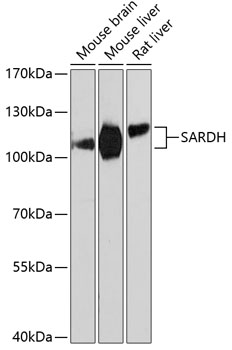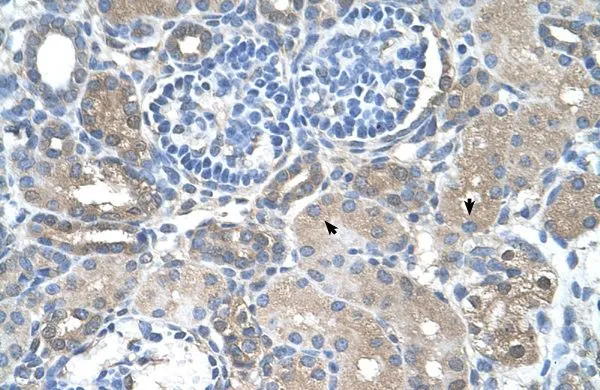
Figure 1. Western blot analysis of SARDH using anti-SARDH antibody (A09641-1). Electrophoresis was performed on a 5-20% SDS-PAGE gel at 70V (Stacking gel) / 90V (Resolving gel) for 2-3 hours. The sample well of each lane was loaded with 30 ug of sample under reducing conditions. Lane 1: human hepatocellular carcinoma tumor tissue (HCCT) lysates, Lane 2: human hepatocellular carcinoma paracancerous tissue (HCCP) lysates, Lane 3: ran pancreas tissue lysates, Lane 4: rat liver tissue lysates, Lane 5: rat kidney tissue lysates, Lane 6: rat RH35 whole cell lysates, Lane 7: mouse pancreas tissue lysates, Lane 8: mouse liver tissue lysates, Lane 9: mouse kidney tissue lysates. After electrophoresis, proteins were transferred to a nitrocellulose membrane at 150 mA for 50-90 minutes. Blocked the membrane with 5% non-fat milk/TBS for 1.5 hour at RT. The membrane was incubated with rabbit anti-SARDH antigen affinity purified polyclonal antibody (Catalog # A09641-1) at 0.25 microg/mL overnight at 4°C, then washed with TBS-0.1%Tween 3 times with 5 minutes each and probed with a goat anti-rabbit IgG-HRP secondary antibody at a dilution of 1:5000 for 1.5 hour at RT. The signal is developed using an Enhanced Chemiluminescent detection (ECL) kit (Catalog # EK1002) with Tanon 5200 system. A specific band was detected for SARDH at approximately 101 kDa. The expected band size for SARDH is at 101 kDa.
Anti-SARDH Antibody Picoband(r)
A09641-1-CARRIER-FREE
ApplicationsFlow Cytometry, Western Blot, ELISA
Product group Antibodies
TargetSARDH
Overview
- SupplierBoster Bio
- Product NameAnti-SARDH Antibody Picoband(r)
- Delivery Days Customer9
- ApplicationsFlow Cytometry, Western Blot, ELISA
- CertificationResearch Use Only
- ClonalityPolyclonal
- Concentration500 ug/ml
- Gene ID1757
- Target nameSARDH
- Target descriptionsarcosine dehydrogenase
- Target synonymsBPR-2, DMGDHL1, SAR, SARD, SDH, sarcosine dehydrogenase, mitochondrial, dimethylglycine dehydrogenase-like 1
- HostRabbit
- IsotypeIgG
- Protein IDQ9UL12
- Protein NameSarcosine dehydrogenase, mitochondrial
- Scientific DescriptionBoster Bio Anti-SARDH Antibody Picoband® catalog # A09641-1. Tested in ELISA, Flow Cytometry, WB applications. This antibody reacts with Human, Mouse, Rat. The brand Picoband indicates this is a premium antibody that guarantees superior quality, high affinity, and strong signals with minimal background in Western blot applications. Only our best-performing antibodies are designated as Picoband, ensuring unmatched performance.
- Storage Instruction-20°C,2°C to 8°C
- UNSPSC12352203





